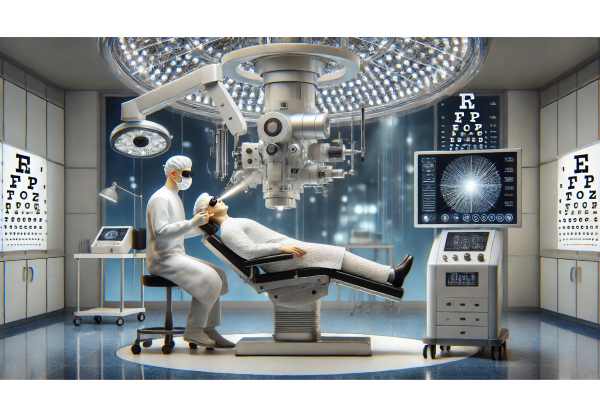
A New Era of Vision Correction: The Latest Breakthroughs in Laser Eye Surgery
Laser eye surgery has revolutionized the way we correct vision, offering a life-changing alternative to glasses and contact lenses. Over the past few decades, advancements in technology have continually refined and improved these procedures, making them safer, more effective, and accessible to a broader range of patients. As the field of ophthalmology progresses, new techniques and innovations are emerging that promise even greater precision, faster recovery times, and better outcomes. Whether you’re considering laser eye surgery for the first time or seeking the latest information on treatment options, understanding these cutting-edge developments can help you make informed decisions about your vision care.
Exploring the Latest Techniques in Laser Eye Surgery
The landscape of laser eye surgery has evolved significantly, with several new techniques and technologies enhancing both the safety and efficacy of these procedures. Here, we delve into the most recent advances that are shaping the future of vision correction.
1. SMILE (Small Incision Lenticule Extraction): A Minimally Invasive Breakthrough
One of the most significant recent advancements in laser eye surgery is SMILE, which stands for Small Incision Lenticule Extraction. This procedure is a minimally invasive alternative to LASIK and PRK, two of the most commonly performed laser eye surgeries. Developed in the early 2010s, SMILE has rapidly gained popularity due to its ability to correct myopia (nearsightedness) with a smaller incision and less disruption to the corneal surface.
a. How SMILE Works
In a SMILE procedure, a femtosecond laser creates a small, lens-shaped piece of tissue called a lenticule within the cornea. The surgeon then makes a tiny incision in the cornea through which the lenticule is extracted. Removing this tissue reshapes the cornea, correcting the refractive error that causes myopia. The entire procedure is done without creating a large flap, as is necessary in LASIK, reducing the potential for complications such as flap dislocation.
b. Benefits of SMILE
SMILE offers several advantages over traditional LASIK, particularly in terms of safety and recovery. The smaller incision, typically less than 4 mm compared to the 20 mm flap in LASIK, preserves more of the corneal nerves and reduces the risk of dry eye syndrome, a common postoperative complaint. Additionally, the cornea’s structural integrity is better maintained, which may be beneficial for patients with thinner corneas who might not be ideal candidates for LASIK.
Patients who undergo SMILE also report quicker recovery times and fewer restrictions post-surgery, making it an attractive option for those with active lifestyles. As SMILE technology continues to evolve, it is being explored for the correction of other refractive errors, such as hyperopia (farsightedness) and astigmatism, further expanding its applicability.
2. Wavefront-Guided LASIK: Personalized Vision Correction
While LASIK has been a popular choice for laser eye surgery since its introduction, advancements in technology have made it even more precise. Wavefront-guided LASIK is one such innovation, offering a highly customized approach to vision correction that addresses both common refractive errors and subtle imperfections known as higher-order aberrations.
a. Understanding Wavefront Technology
Wavefront technology involves creating a detailed map of the eye’s unique optical imperfections using a wavefront aberrometer. This device measures how light waves travel through the eye, identifying not only the standard refractive errors (myopia, hyperopia, and astigmatism) but also higher-order aberrations that can affect vision quality, such as glare, halos, and difficulty seeing at night.
Once this wavefront map is created, it guides the excimer laser during the LASIK procedure, allowing for the correction of these specific imperfections. The result is a more personalized and precise vision correction that can lead to better outcomes, particularly in challenging visual environments.
b. Advantages of Wavefront-Guided LASIK
The primary benefit of wavefront-guided LASIK is its ability to provide sharper, clearer vision, especially for patients who might otherwise experience issues like glare or halos after standard LASIK. By addressing higher-order aberrations, this technique can significantly enhance night vision and overall visual clarity, offering superior results for patients with complex prescriptions.
Additionally, because wavefront-guided LASIK is tailored to the individual’s unique eye structure, it reduces the risk of postoperative complications and the need for additional corrective procedures. This personalized approach has made wavefront-guided LASIK a preferred option for patients seeking the highest quality of vision correction available.
3. Topography-Guided LASIK: Tailoring Treatment to Corneal Shape
Another recent development in laser eye surgery is topography-guided LASIK, a technique that takes into account the specific shape and contours of the cornea. This approach offers a level of customization that further enhances the precision of vision correction, particularly for patients with irregular corneas or those who have had previous eye surgeries.
a. How Topography-Guided LASIK Works
Topography-guided LASIK begins with a comprehensive mapping of the cornea’s surface using a corneal topographer. This device creates a detailed 3D model of the cornea, highlighting areas of unevenness or irregularity. Based on this topographic map, the excimer laser is programmed to reshape the cornea in a way that smooths out these irregularities while correcting refractive errors.
The detailed corneal mapping allows for a more refined treatment, particularly beneficial for patients with conditions like keratoconus or those who have undergone previous refractive surgeries that resulted in irregular corneal shapes.
b. Benefits of Topography-Guided LASIK
Patients who undergo topography-guided LASIK often experience better visual outcomes, especially in terms of quality of vision. This procedure can address specific issues like visual distortions, double vision, and difficulties with night vision that might not be fully corrected by traditional LASIK or other forms of laser eye surgery.
Moreover, by tailoring the treatment to the exact shape of the cornea, topography-guided LASIK can reduce the risk of postoperative complications, such as corneal ectasia, a condition where the cornea becomes progressively thinner and bulges forward. This makes it a safer and more effective option for patients with pre-existing corneal irregularities.
Emerging Technologies and the Future of Laser Eye Surgery
The field of laser eye surgery is continually advancing, with new technologies and techniques on the horizon that promise to further improve patient outcomes and expand the possibilities of vision correction.
1. Femtosecond Laser-Assisted Surgery
The introduction of femtosecond lasers has already transformed laser eye surgery by allowing for more precise and controlled cuts, particularly in flap creation for LASIK procedures. However, the application of femtosecond lasers is expanding beyond traditional refractive surgery.
In cataract surgery, for instance, femtosecond lasers are being used to perform key steps of the procedure with greater accuracy, leading to improved outcomes and faster recovery times. As the technology develops, it is expected that femtosecond lasers will play a larger role in a broader range of ophthalmic surgeries, further enhancing safety and precision.
2. Presbyopia-Correcting Laser Surgery
Presbyopia, the age-related loss of near vision, has traditionally been corrected with reading glasses or multifocal contact lenses. However, new laser techniques are being developed to address this condition more effectively. These include laser treatments that reshape the cornea to improve near vision without compromising distance vision, as well as procedures that create a multifocal corneal pattern to enhance the eye’s ability to focus at different distances.
As these technologies mature, they offer the potential for long-term solutions to presbyopia, reducing the dependence on reading glasses and providing more natural vision correction for aging eyes.
3. Adaptive Optics and Customized Ablation Profiles
Adaptive optics, a technology originally developed for astronomy, is now being applied to laser eye surgery. This technology allows for real-time adjustments during surgery, compensating for changes in the eye’s shape and movement to achieve even more precise results. When combined with customized ablation profiles, which tailor the laser’s action to the specific needs of the patient’s eye, adaptive optics represents a significant leap forward in the accuracy and effectiveness of laser eye surgery.
This approach could lead to a new standard in personalized vision correction, where each surgery is uniquely tailored to the patient’s anatomy, ensuring the best possible outcomes with minimal side effects.
Making an Informed Decision: Is Laser Eye Surgery Right for You?
With the rapid advancements in laser eye surgery, the options available today are more varied and effective than ever before. Whether you’re considering a well-established procedure like LASIK or exploring newer techniques like SMILE or topography-guided LASIK, it’s essential to consult with a qualified ophthalmologist to determine the best approach for your individual needs.
1. Evaluating Candidacy
Not everyone is a suitable candidate for laser eye surgery, and the first step is to undergo a thorough eye examination. Factors such as the thickness of your cornea, your prescription, and any pre-existing eye conditions will be evaluated to determine the best course of action. Your lifestyle, occupation, and visual demands will also play a role in selecting the most appropriate procedure.
2. Understanding the Risks and Benefits
While laser eye surgery has a high success rate, it’s important to be aware of the potential risks and side effects, which can vary depending on the type of surgery and your individual circumstances. Common risks include dry eyes, glare, halos, and, in rare cases, more serious complications like infection or vision loss. Discussing these risks with your surgeon will help you make an informed decision about whether the benefits outweigh the potential downsides.
3. Considering the Costs
The cost of laser eye surgery can vary widely depending on the procedure, the surgeon’s experience, and the technology used in the surgery. While laser eye surgery can be a significant financial investment, it’s important to weigh this against the long-term benefits of potentially reducing or eliminating the need for glasses or contact lenses. Many clinics offer financing options to help manage the cost, and some procedures may even be covered by insurance if they are deemed medically necessary.
It’s also worth considering the indirect costs associated with alternative vision correction methods. Over time, the cost of glasses, contact lenses, and related supplies can add up, making laser eye surgery a cost-effective option in the long run for many people.
4. Preparing for the Procedure
Once you’ve decided to proceed with laser eye surgery, preparation is key to ensuring the best possible outcome. Your surgeon will provide detailed instructions on how to prepare, which may include stopping the use of contact lenses for a period before the surgery to allow your corneas to return to their natural shape. You might also be advised to avoid certain medications or products that could interfere with the procedure or healing process.
It’s important to follow these pre-surgery guidelines closely, as they can significantly impact the effectiveness of the surgery and your recovery.
5. Post-Surgery Care and Recovery
Recovery from laser eye surgery varies depending on the type of procedure, but in general, most patients experience only mild discomfort and can return to normal activities within a few days. Your surgeon will provide specific post-operative care instructions, which may include using prescribed eye drops to prevent infection and reduce inflammation, avoiding strenuous activities, and protecting your eyes from bright light.
Regular follow-up appointments are crucial to monitor your healing and ensure that your vision is improving as expected. While many patients achieve their desired results after a single procedure, some may require a follow-up treatment to fine-tune the correction.
6. Long-Term Considerations
While laser eye surgery can offer long-lasting results, it’s important to have realistic expectations. Vision naturally changes with age, and you may still require reading glasses or other vision aids as you get older, especially if you develop conditions like presbyopia or cataracts.
Staying informed about ongoing advances in laser eye surgery is also beneficial, as new treatments may become available that could further enhance or maintain your vision as you age. Keeping in touch with your ophthalmologist and scheduling regular eye exams will help you stay on top of any changes in your vision and ensure that you continue to enjoy the benefits of your surgery for years to come.










